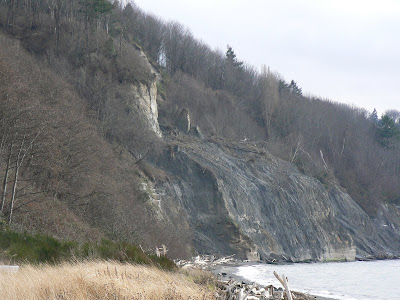Tucked in the upper reaches of Carkeek Park is an old orchard, planted by homesteaders in 1890 or so. For the past thirty years or so, volunteers, including the
Friends of Piper's Orchard have been tending it and planting more trees. About 15 of the original plantings remain, ancient breeds such as Wealthy, Red Astrachan,Gravenstein and Guyot Pear.
I watched a flock of about 70
pine siskins flutter around the orchard and then settle on a big tree at the back (a Rhode Island Greening, if I'm reading the
map correctly). It is a magnificent tree. Really, I should have lingered and taken a good portrait of it. But instead I took bad pictures of the birds...

...who promptly flew away.

Pine siskins spend their winters roaming around in flocks. Where they go depends on the supply of seeds. They seldom winter in the same area two years in a row. This year, they favored our region, and
showed up on in record numbers on the Christmas Bird Counts. They're fun to watch.
In his "Essential Field Guide Companion," Pete Dunne describes the pine siskin as "a quick, nervous, dark, drab, ultra-streaky pipsqueak of a bird that makes up in sass and belligerence what it lacks in size." Pete Dunne is fun to read.
Moving along a trail, a willow which fell down over the winter is still alive.

But then, it is hard to kill a willow. These are trees that evolved to coexist with beavers, ruthlessly efficient tree downers, who happen to find willow cambium delicious. But then there are plants that are tougher, such as the ivy still growing up the willow's trunk.

 It's a satyr comma. I don't know how this insect is anything like the man-goat hybrids that cavorted around the god Pan, but the comma name is for the white mark on his lower underwings.
It's a satyr comma. I don't know how this insect is anything like the man-goat hybrids that cavorted around the god Pan, but the comma name is for the white mark on his lower underwings.
 This species hibernates as adults, emerging on warm days. I suppose that a good chunk of Saturday in Victoria qualified as a warm day. There were two of them in the Oak Bay Native Plant garden. I think they were both males. One reason I think this is that both had the same bright coloring. The other is that in between spells of basking in patches of sunlight, they would fly at each other, in a flurry of wing-beats, sometimes touching. It was probably quite a savage scene from a butterfly's perspective.
This species hibernates as adults, emerging on warm days. I suppose that a good chunk of Saturday in Victoria qualified as a warm day. There were two of them in the Oak Bay Native Plant garden. I think they were both males. One reason I think this is that both had the same bright coloring. The other is that in between spells of basking in patches of sunlight, they would fly at each other, in a flurry of wing-beats, sometimes touching. It was probably quite a savage scene from a butterfly's perspective.



























